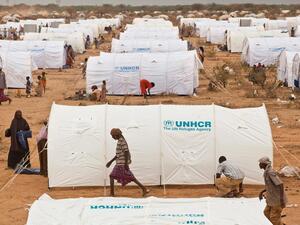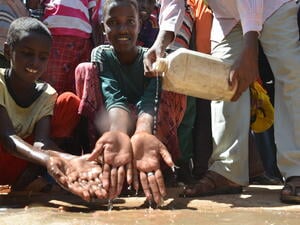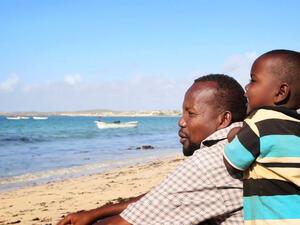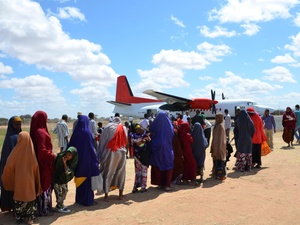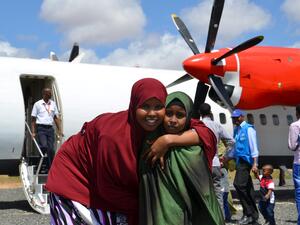Kenya: Somalis arriving
Kenya: Somalis arriving
An average of 100 Somali refugees are arriving every day at Dadaab in north-east Kenya. But UNHCR is concerned that the figure could rise much higher if hostilities in neighbouring Somalia escalate. Many of those who have arrived in the past week said they had fled Mogadishu to escape fighting between the Union of Islamic Courts and a loose alliance of warlords, who controlled the Somali capital for years. The UIC seized control of Mogadishu in June.
Since the beginning of the year, some 18,000 Somali refugees have arrived in Dadaab, where three refugee camps already hosted some 134,000 mainly Somali refugees. If the current rate of arrival continues, we can expect another 12,000 refugees by the end of the year. But this number could be much higher if the fighting gets worse in Somalia. We would need to open a fourth camp and raise more funds to cope with the inflow.
The refugees who arrive in the semi-arid region of Dadaab are generally in good health, but many are visibly exhausted from the long trek. One man, who fled Mogadishu after his two brothers were killed in a gun battle in the capital, said he had been on the road for more than three weeks, travelling mainly on foot.
Some of the refugees who arrived in Dadaab on Wednesday said they had walked or hitched rides from passing trucks as they made their way south from Mogadishu to the port city of Kismayo before continuing north-west to Amuma, a crossing point on the Kenya-Somalia border. Amuma is some 100 km from Dadaab. Somali refugees are also entering Kenya through the border crossing at Doble, which is 98 km from Dadaab.
Upon arrival in Dadaab, the refugees are received at a registration centre where UNHCR staff carry out a rapid screening exercise. By yesterday, we had some 600 newly arrived refugees awaiting screening and registration. Our staff in Dadaab is now busy preparing additional accommodation areas to shelter the new arrivals at the registration centre.
In some sites, we have to build additional sanitation facilities. We are also ensuring that these new sites are as close as possible to water points in the camp. New arrivals receive basic household items such as blankets, jerry cans, mats and kitchen utensils, but our current stocks are very limited.
There are 227,400 refugees in Kenya, mainly from Somalia and Sudan.
Meanwhile, the UNHCR-led joint inter-agency assessment mission to remote areas of eastern Ethiopia, returned to Addis Ababa late yesterday. They had been on the ground since August 2. The mission did not find any evidence of refugees from Somalia in that part of Ethiopia, but some cases are still being verified.
The main goal of the mission was to see if Somali refugees had crossed into that part of Ethiopia and to make a needs assessment. WFP, UNICEF, UNDP, OCHA, FAO and UNDSS also participated in the nine-day mission, which covered about a dozen localities in the Gode-Ferfer and Gode-Dolo Bay areas. These could be main entry points if people flee into Ethiopia from Somalia.
There are currently 99,000 refugees in Ethiopia. Most are from Sudan, but there are 16,000 Somalis in Kebribeyah camp, near Jijiga in north-east Ethiopia. In the early 1990s, there were 628,000 Somali refugees in eight camps in eastern Ethiopia. Since 1997, when UNHCR began repatriating refugees to north-western Somalia, most of the camps have been closed.


